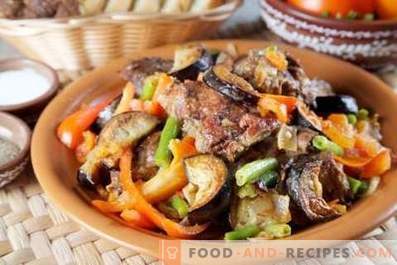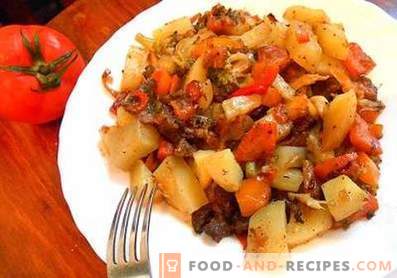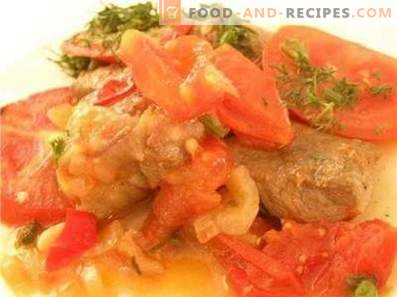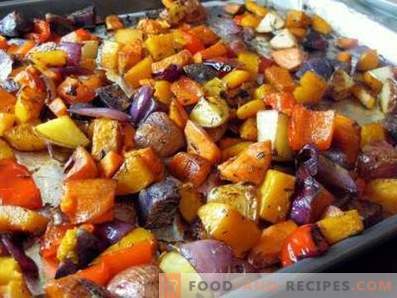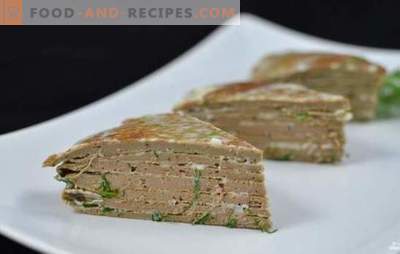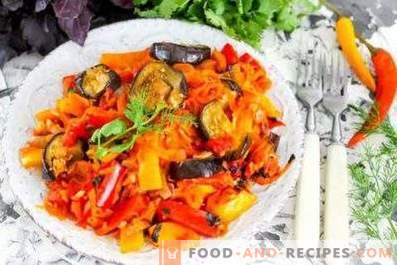
In all national cuisines there is a specific dish made from a mixture of different vegetables, which the inhabitants of the respective territories cook and eat especially willingly. In the republics of Transcaucasia this dish is Ajapsandal. Armenians, Abkhazians and Georgians consider him to be theirs. These nations often cook adzhapsandal, love it very much and are proud that they have such a pleasant taste and healthy vegetable dish. Every Georgian family, for example, has its own unique recipe for Ajapsandal, and it’s simply impossible to find a hostess who cannot cook this dish. However, there is nothing difficult in the preparation of adzhapsandal, and with knowledge of some subtleties, any hostess can learn how to do it, regardless of the country of residence.
Cooking Features
In order for a vegetable dish not to turn into a regular stew, but it was precisely Ajapsandal, you need to be well aware of how it is prepared. There are several points that may seem insignificant at first glance, but which are actually very important. These points need to know and take into account when choosing foods, and when preparing the dish itself.
- Initially, Ajapsandal was a purely vegetable dish, but later it was also cooked with meat. When adding meat to a dish, it is important not to overdo it, so that its taste is not dominant.
- Eggplants are a part of ajapsandal. Georgians prefer ripe, already soft vegetables, but you can choose any. The main thing is to remove the solanine from them, which gives the eggplants bitterness and can ruin the taste of the finished dish. For this, the eggplants are salted and washed after a quarter of an hour. You can dip them for 20-30 minutes in a solution prepared from 10 g of salt and 1 liter of water.
- The second important component of ajapsandal is the sweet pepper. In fact, pepper of a different color does not have exactly the same taste: green fruits are a bit tougher than red ones. For ajapsandal, it is better to take green pepper, red can be added only in small quantities in order to make the dish look brighter and more appetizing.
- Spices and spices also play a significant role. Most often, the basis of the bouquet are cilantro and basil, as well as hot red pepper. Almost always add garlic, which is pounded before it in a mortar. If you grind it in another way, the taste of the dish will be slightly different.
- Prepare adzhapsandal in dishes with thick walls and heavy bottom. In such dishes, the heat is well preserved, and the vegetables become softer much faster, they get better saturated with each other's aroma. However, cooking time should not be exceeded, otherwise the dish will turn into a homogeneous mass, resembling vegetable caviar. This ajapsandal should not be so.
There are a lot of recipes for the preparation of ajapsandal, they can differ very slightly, for example, the set and ratio of spices used, or have significant differences. From the recipe and method of cooking a dish depends largely on the process of cooking, but the general rules remain the same.
Ajapsandal in Georgian
Calorie dishes: 1226 kcal, per 100 g: 48 kcal.
Composition:
- eggplants - 1 kg;
- sweet pepper - 0, 5 kg;
- hot peppers - 1 pc .;
- tomatoes - 0.5 kg;
- garlic - 1 head;
- onions - 0, 3 kg;
- fresh coriander - 20 g;
- fresh basil - 20 g;
- fresh parsley - 20 g;
- ground coriander - 2-3 g;
- salt, ground pepper - to taste;
- vegetable oil - as required.
Method of preparation:
- Wash, dry eggplants. Cut in half lengthwise, cut off the tips. Cut into semicircles 2-3 mm thick. Put in a bowl, sprinkle with coarse salt, stir with your hands and leave for 10 minutes. After the indicated time, rinse thoroughly in running water. If the eggplants are left in salt for a longer period or washed out poorly, they will be salted.
- Wash the sweet pepper. Cut the stalk. Cut in half lengthwise, remove the seeds. Cut into half rings by 2-3 mm wide.
- Wash tomatoes. On the side opposite to the stem, incise their skin with two perpendicular lines. Boil the water and dip the tomatoes in it for 2 minutes. Remove them with a skimmer and cool them by dipping them in cool water for a few minutes. Take out and clean. Cut tomato pulp into small cubes.
- Wash hot pepper, remove the stalk. Cut the pod into small rings. The seeds of them are better to choose, otherwise the dish will turn out to be overly spicy.
- Chop a pair of garlic cloves finely and ceiling in a mortar with salt, pepper and ground coriander.
- Cut the remaining garlic into thin plates.
- Wash, shake greens and chop it with a knife.
- Peel the onion, cut it into thin half-rings or quarter-rings of the rings if the onions are too large.
- Heat the butter in a pan, put the eggplants in it and fry them until they are semi-soft. Transfer them to a dish or immediately to the cauldron, where they will be stewed with the rest of the vegetables.
- In the same pan, where the eggplants were fried, fry the sweet pepper for 5 minutes, mixing it with the hot pepper rings. Put the roasted peppers to the eggplants.
- Place the onion in the pan in the place of the pepper. Fry it until soft and move it into a container with other fried vegetables.
- Place tomatoes in a frying pan. Saute them in a frying pan under the lid until they turn into a homogeneous mass, mix with crushed garlic, herbs and garlic. Pour this mixture of vegetables in the cauldron.
- Put the cauldron on the fire and simmer the vegetables for 35-40 minutes. If the tomatoes seem juicy to you, you can add a little water so that the vegetables do not burn. While cooking vegetables can be gently mixed.
Ajapsandal, cooked according to one of the most common Georgian recipes, can be served as a separate dish or as a side dish for meat.
Ajapsandal with meat
Calorie dishes: 2456 kcal, per 100 g: 86 kcal.
Composition:
- eggplants -0, 5 kg;
- pork - 0, 25 kg;
- tomatoes - 0.5 kg;
- potatoes - 0.5 kg;
- carrots - 150 g;
- onions - 0, 3 kg;
- Bulgarian pepper - 0, 5 kg;
- parsley - 50 g;
- garlic - 2 cloves;
- dried basil - 10 g;
- butter - 50 g;
- vegetable oil - 50 ml;
- salt, spices - to taste.
Method of preparation:
- Rinse the meat, pat dry with napkins. Cut into small cubes of about 1 cm.
- Peel the carrots, cut them in the same cubes about 0.5 cm.
- Onions, freeing from the husk, cut into thin quarters of rings.
- Fry the meat in vegetable oil so that the pieces are well browned.
- Add carrots and onions to the meat. Continue frying, stirring, for another 5 minutes. Pepper and salt. Fry another couple of minutes and remove from heat.
- Peel the eggplants, cut them into small cubes. Prepare a saline solution by dissolving a tablespoon of salt in 2 liters of water. Put the eggplants in it, rinse them well after 20 minutes, put them in a colander. Wait for the water to drain.
- Mince the garlic in a mortar with salt and spices.
- Dip the tomatoes with boiling water, peel and chop with a knife.
- Peel the potatoes. Cut the tubers into small cubes.
- Wash the pepper. Remove the stalks and seeds. Cut the flesh into small squares.
- Melt butter in a cauldron or deep frying pan with a thick bottom. Put the potatoes and eggplants, fry them in butter for 5 minutes.
- Add meat with onions and carrots.
- Lay the paprika and tomatoes, after mixing them with chopped greens. Add basil and crushed garlic.
- Simmer the dish over low heat, stirring occasionally for 45 minutes. Make sure the vegetables are not burnt by adding water if necessary.
Ajapsandal prepared according to this recipe turns out to be very satisfying and may well become a full-fledged dinner.
Ajapsandal on the grill
Caloric content of the dish: 438 kcal, per 100 g: 26 kcal.
Composition:
- eggplants - 0, 4 kg;
- tomatoes - 0, 4 kg;
- young zucchini - 0, 4 kg;
- sweet Bulgarian pepper - 0, 4 kg;
- onions - 100 g;
- garlic - 2 cloves;
- salt, pepper, fresh herbs - to taste.
Method of preparation:
- Wash vegetables and pat dry.
- String vegetables on skewers, highlighting a separate skewer for each type of vegetables, as their cooking time will be different. On skewers do not need to string only onions and garlic.
- Fry the vegetables on the grill, turning them more often. Tomatoes will be ready first, the most time it takes for eggplants - they should be completely soft.
- Cool and peel the vegetables, cut their pulp into small cubes.
- Finely chop the garlic with a knife.
- Free the onion from the husk, cut it into small pieces.
- Finely chop the greens.
- Add onions, garlic, greens to vegetables. Pepper, salt and mix.
Cooked on the grill adzhapsandal will be the perfect snack for barbecue, but it is good as an independent dish.
Ajapsandal in the oven
Calorie dishes: 1100 kcal, per 100 g: 47 kcal.
Composition:
- eggplants - 0, 8 kg;
- tomatoes - 0, 4 kg;
- Bulgarian pepper - 0, 8 kg;
- onions - 0, 2 kg;
- garlic - 1 head;
- hot peppers - 1 pc .;
- fresh parsley - 20 g;
- fresh basil - 10 g;
- fresh coriander - 10 g;
- apple cider vinegar (6%) - 20 ml;
- vegetable oil - as needed;
- salt, pepper - to taste.
Method of preparation:
- Wash and dry the vegetables. Cut the peppers and eggplants along. Remove seeds from peppers. Salt the eggplants and leave for 10 minutes, then wash and dry again with a napkin.
- Lubricate the peppers and eggplants with oil and send to an oven heated to 180 degrees for 25-30 minutes. After a specified time, remove them and cool, chop with a knife. Eggplant should be cleaned.
- Peel the tomatoes and chop with a blender or simply chop finely. Heat for 5 minutes in the oven, mix with the rest of the vegetables.
- Add crushed garlic, finely chopped paprika, chopped greens, chopped onion into small pieces.
- Mix vinegar with the same amount of vegetable oil. Sprinkle ajapsandal with the mixture before serving.
Ajapsandal from baked vegetables has a unique taste, as if it is a completely different dish. It is worth trying to cook at least once.
Video: Ajapsandal - a super recipe for lean vegetable stew!
Ajapsandal is a tasty and fragrant vegetable dish typical of Armenian, Georgian and Abkhazian cuisine. It is quite spicy, so especially those who like savory dishes will like it.
